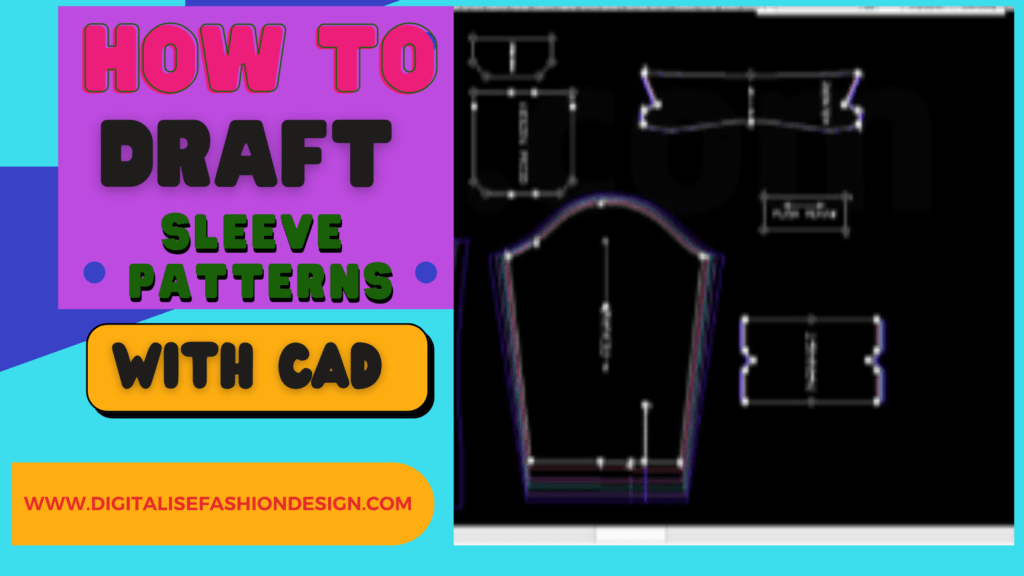Introduction
CAD pattern grading ,makes grading of patterns a breeze.
If you’ve ever dabbled into fashion design, you know that creating patterns is just the beginning.
The real challenge often lies in pattern grading—adjusting a pattern to different sizes while maintaining the design’s integrity.
This task, while crucial, can be time-consuming and prone to error.
Enter CAD (Computer-Aided Design), a game-changer in the world of fashion. CAD pattern grading simplifies the process, making it faster, more accurate, and accessible even for beginners.
The importance of CAD pattern grading in fashion design
CAD Pattern grading is the bridge between a single design and a full-size range.
It ensures that a garment fits well across different body types, which is vital for any successful fashion line.
In the past, pattern grading was done manually, a meticulous process that required a lot of skill and patience.
Today, CAD technology has made it possible to automate much of this process, allowing designers to focus on creativity rather than technical details.
How CAD pattern grading has transformed the fashion industry
CAD pattern grading technology has completly changed pattern grading process by offering tools that enhance precision, reduce manual errors, and speed up the entire process.
I have always had a challenge with this process.
Particularly when you are just starting out in pattern drafting.
I believe you can relate.
But fortunately, with CAD, what once took hours or even days can now be accomplished in minutes.
For beginners, CAD provides an intuitive interface that simplifies the learning curve, making it easier to produce professional-quality patterns right from the start.
What is CAD Pattern Grading?
Definition and Basics

CAD pattern grading is the process of using computer software to scale a base pattern to different sizes. This involves creating a set of rules that determine how the pattern should change for each size. The software then applies these rules automatically, producing a range of sizes that are all perfectly graded.
Traditional vs. CAD Pattern Grading
Traditionally, pattern grading was done by hand, using rulers, pencils, and grading notches. This manual process was not only slow but also susceptible to human error. CAD pattern grading, on the other hand, leverages software to handle the calculations and adjustments, ensuring consistency and accuracy. While traditional methods required extensive experience and training, CAD allows even beginners to achieve professional results.
Why Use CAD for Pattern Grading?
Efficiency and Precision
One of the biggest advantages of CAD pattern grading is its efficiency. The software handles the tedious aspects of grading, allowing designers to focus on creativity. Precision is another key benefit—CAD tools ensure that every size is graded correctly, reducing the likelihood of fit issues.
Cost-Effectiveness
For small businesses or independent designers, CAD pattern grading can be a cost-effective solution. It reduces the need for physical samples and minimizes waste, which translates to lower production costs. Additionally, the time saved by using CAD can be redirected towards other aspects of the business, further improving profitability.
Getting Started with CAD Pattern Grading
Choosing the Right Software
The first step in CAD pattern grading is selecting the right software. There are several options available, each with its own strengths. Popular choices include Optitex, Gerber AccuMark, and Lectra Modaris. When choosing software, consider factors such as ease of use, features, and support resources.
System Requirements and Setup
Before diving into CAD pattern grading, make sure your computer meets the system requirements for the software you choose.
Most CAD programs require a decent processor, sufficient RAM, and a quality graphics card. Setting up your workspace correctly is also crucial—ensure you have a comfortable working environment, as pattern grading can require long hours of focus.
Understanding the Fundamentals of CAD Pattern Grading
Key Terminologies
Before you start grading patterns, it’s important to familiarize yourself with key terminologies. Terms like “grade rule,” “base size,” and “size range” are fundamental to understanding how grading works in CAD.
A grade rule, for instance, defines the amount of change applied to a pattern piece as it scales from one size to another.
Basic Concepts
At its core, CAD pattern grading involves shifting pattern points according to specific rules.
For example, when grading up a size, you might add a certain amount to the waist, hip, and length.
CAD software automates these shifts, but understanding the underlying concepts is key to using the software effectively.
Step-by-Step Guide to CAD Pattern Grading
Importing Your Base Pattern
The first step in CAD pattern grading is to import your base pattern into the software. This pattern serves as the starting point for all size variations. Most CAD software allows you to import patterns in various formats, such as DXF or PDF.
Setting Up Grading Rules
RELATED BLOG POST
Once your base pattern is imported, the next step is to set up grading rules. These rules define how much each part of the pattern should be adjusted for different sizes. For instance, you might specify that the bust increases by 1 inch for each size up.
Grading Across Different Sizes
After setting up your grading rules, the software will automatically generate the pattern pieces for each size. You can then review and adjust these pieces as needed. This is where CAD really shines, as it allows you to visualize the graded patterns and make any necessary tweaks before moving forward.
Tips for Accurate CAD Pattern Grading
Checking and Adjusting Measurements
Even with CAD, it’s important to double-check your measurements. Ensure that the graded patterns align with the intended size chart. Small errors in grading rules can lead to significant fit issues, so take the time to review your work carefully.
Avoiding Common Mistakes
Common mistakes in CAD pattern grading include incorrect grading rules, misalignment of pattern pieces, and overlooking key details like notches and seam allowances. Avoid these pitfalls by regularly reviewing your work and using the software’s tools to catch errors.
Advanced Techniques in CAD Pattern Grading
Custom Grading for Unique Designs
One of the benefits of CAD is its flexibility.
You can create custom grading rules for unique designs, allowing you to experiment with different shapes and styles. For instance, you might create a pattern that grades differently for the bust and waist to achieve a specific fit.
Creating Grading Variations
CAD also allows you to create multiple grading variations for the same pattern. This is useful if you want to offer different fits, such as a regular fit and a slim fit, from the same base pattern. By saving these variations within the software, you can easily switch between them as needed.
Common Challenges and How to Overcome Them
Troubleshooting Software Issues
Like any software, CAD programs can sometimes run into issues. Common problems include crashes, slow performance, and difficulty importing patterns. Most of these issues can be resolved by updating the software, checking your system settings, or consulting the user manual.
Dealing with Complex Patterns
Grading complex patterns, such as those with intricate details or unusual shapes, can be challenging even with CAD. In these cases, it may be necessary to break down the pattern into simpler components and grade them individually before reassembling the final design.
Integrating CAD Pattern Grading with Other Tools
Syncing with 3D Modeling Software
One of the most exciting developments in fashion technology is the integration of CAD pattern grading with 3D modeling software.
This allows designers to visualize how a graded pattern will look on a 3D model, providing valuable insights before the pattern is sent to production.
Exporting Graded Patterns for Production
Once your pattern is graded and ready, the final step is to export it for production. Most CAD software allows you to export patterns in various formats suitable for different manufacturing processes.
This ensures that the patterns can be used directly by the production team, reducing the risk of errors and ensuring a smooth workflow.
The Role of CAD Pattern Grading in Sustainable Fashion
Reducing Waste Through Precision
Sustainability is a growing concern in the fashion industry, and CAD pattern grading plays a key role in addressing this issue. By ensuring that patterns are graded accurately, CAD helps reduce fabric waste during the production process. This not only saves resources but also reduces the environmental impact of fashion manufacturing.
Enhancing Reusability of Patterns
Another benefit of CAD is the reusability of patterns. Once a pattern is graded, it can be easily adjusted and reused for different collections or designs. This reduces the need to create new patterns from scratch, further contributing to a more sustainable design process.
Case Studies: Success Stories in CAD Pattern Grading
Real-World Applications
Many fashion brands have successfully implemented CAD pattern grading to streamline their design and production processes. For instance, some independent designers have reported saving hours of work per project by using CAD, allowing them to take on more clients and grow their businesses.
Lessons Learned from Industry Experts
Industry experts often highlight the importance of mastering the basics before diving into advanced techniques.
Understanding the core principles of pattern grading will make it easier to leverage the full potential of CAD tools.
Additionally, staying updated with the latest software updates and industry trends is crucial for maintaining a competitive edge.
Future Trends in CAD Pattern Grading
AI and Machine Learning in Pattern Grading
The future of CAD pattern grading looks promising, with emerging technologies like AI and machine learning set to play a significant role.
These technologies can automate even more aspects of pattern grading, such as predicting fit issues and suggesting optimal grading rules based on past data.
The Future of Fashion Technology
As fashion technology continues to evolve, CAD pattern grading will likely become even more integrated with other tools and processes. From virtual fashion shows to on-demand manufacturing, the possibilities are endless. For designers, this means more opportunities to innovate and bring their creative visions to life.
Conclusion
CAD pattern grading has transformed the fashion industry, making it easier than ever to create well-fitting garments across a range of sizes.
It does not matter if you’re a seasoned designer or a beginner, mastering CAD pattern grading can open up new possibilities for your work.
As the technology continues to evolve, staying ahead of the curve will be key to success in the ever-changing world of fashion design.
FAQs
What is the Best CAD Software for Pattern Grading?
The best CAD software depends on your specific needs and experience level. Popular options include Optitex, Gerber AccuMark, and Lectra Modaris.
Can I Learn CAD Pattern Grading Without a Background in Fashion?
Yes, many CAD software programs are designed with beginners in mind, offering tutorials and resources to help you learn even if you’re new to fashion design.
How Long Does It Take to Master CAD Pattern Grading?
The time it takes to master CAD pattern grading varies depending on your prior experience and the complexity of the software. On average, it can take a few months of regular practice.
Is CAD Pattern Grading Cost-Effective for Small Businesses?
Yes, CAD pattern grading can be cost-effective for small businesses by reducing the need for physical samples and minimizing fabric waste.
What Are the Most Common Mistakes in CAD Pattern Grading?
Common mistakes include incorrect grading rules, misalignment of pattern pieces, and overlooking important details like notches and seam allowances.








